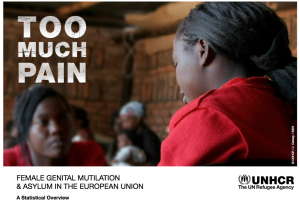UN High Commissioner for Refugees, Too Much Pain: Female Genital Mutilation & Asylum in the European Union – A Statistical Overview, February 2013
The report aims to support ongoing advocacy at EU and CoE level on sexual and gender-based violence (SGBV) in general and female genital mutilation (FGM) in particular as these relate to the asylum system and to girls and women of concern to UNHCR.
Briefly, “Too Much Pain” provides unique statistical evidence for six aspects of FGM and asylum in EU MS :
- Where do girls and women from FGM-practising countries of origin seek asylum in the EU ? – This first set of data provides an overview of the destination countries for the approximately 20,000 women and girls who seek asylum from FGM-risk countries of origin in the EU every year.
- Which FGM-practising countries do these girls and women come from ? – This set of data in turn focuses on the countries of origin of these 20,000 girls and women, and looks at the different patterns of applications in the main asylum countries.
- Where do these girls and women settle in the EU ? – This set examines where girls and women from FGM-practising countries of origin granted international protection settle and integrate in the EU.
- What is the prevalence of FGM amongst female asylum seekers in the EU ? – This set identifies the estimated FGM prevalence and constitutes a direct contribution to the EIGE study on FGM prevalence in the EU and Croatia.
-
Where do refugee girls under 14 seeking asylum from FGM-risk countries of origin settle in the EU ? – The following set seeks to estimate the number of refugee girls from FGM-practising countries of origin who settle every year in EU Member States, and who should be fully incorporated into prevention, prosecution and protection responses to end FGM in the diasporas of the EU.
-
How many asylum claims are based on fear of FGM ? – In the absence of disaggregated data collected by the EU asylum authorities on the grounds for international protection in general, and FGM in particular, the last set of data seeks to provide estimates of the number of asylum claims on FGM grounds the top destination asylum countries may handle every year.
Télécharger (PDF – 850 Mo)

